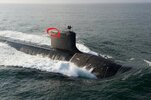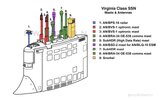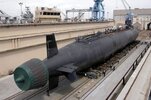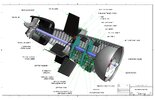That "steam" was diesel exhaust. The ship was providing its own electrical power via the diesel generator, which exhausts from the upper, aft end of the sail.
The screw on the Virginia class is a propulsor, as opposed to an unshrouded screw. And yes, submarine screw/propulsor technology is top secret information. We were generations ahead of the Soviets...up until Toshiba sold top secret submarine screw manufacturing technology to the Soviets in the late 80s (at least four huge machines from Toshiba Machine Company used to mill submarine screws, including the computer programs to operate the machines, via the Norwegian company Kongsberg Vapenfabrik). Though apparently the parent company Toshiba did not know about this, it's the reason why I will NEVER knowingly buy Toshiba products, ever.
When a submarine pulls into drydock, a cover is placed over the screw so that it's not visible as the water is pumped down in the drydock.
In fact, the only place where you can see ANY nuclear submarine screw from one of our submarines is at the Submarine Force Museum in Groton Connecticut, which has the USS Nautilus' screws on display outside. This is because the Nautilus' screws were essentially WWII submarine screws, which look like surface ship screws (which makes sense, as submarines of that era were essentially submersible ships that spent most of their time on the surface transiting from one place to another).
As for heat signatures...water provides a fantastic mask for heat transmission. Heat cannot be transmitted (radiated) through the water for easy detection at any distance like it can through air or a vacuum, even though it's an excellent conductor of heat.
That "chin" is part of the sonar system. The tarps along the sides cover side-mounted sonar arrays, too. The sonar capabilities of a Virginia class boat must be generations ahead of all prior systems.
Some pics and whatnot:











